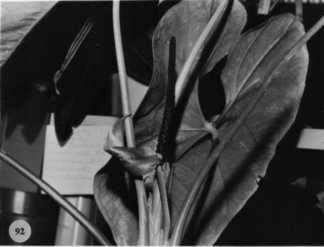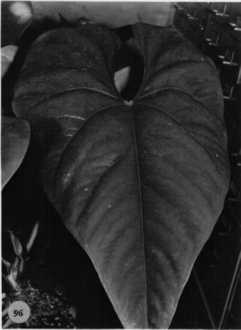





Anthurium lancetillense Croat,
sp. nov. TYPE: Honduras. Atlantida: Lancetilla Valley, ca. 10 mi SE of Tela; in forest preserve along Río Lancetilla, on trail to water reservoir; 10-150 m elev., Croat 42672 (MO-2583478-79, holotype; EAP, K, MEXU, SEL, TEFH, US, isotypes; Live at MO).
Planta terrestris; caudex ad 15 cm longus; petiolus 17-82 cm longus, teres; lamina anguste ovata, 38-54 cm longa, 20-35 cm lata, basi cordata profunde; inflorescentia effusa-erecta, foliis breviora; pedunculus 3.5-36 cm longus: spatha viridis, interdum intra purpurea, lanceolata, 8.5-16 cm longa, 2-3.2 cm lata; spadix atropurpureus, 11-20.5 cm longus; pollen aurantiacum; baccae aurantiacae, ovoideae.
Terrestrial; stems to 15 cm long, 2.5-3 cm diam.; leaf scars conspicuous, 2.3-3 cm wide; roots tan, 6-8 mm diam., descending; cataphylls subcoriaceous, 9-13 cm long, acute at apex, minutely subapiculate, drying tan, dilacerating at base, remaining intact at apex, persisting around base of leaves.
LEAVES with petioles erect, 17-82 cm long, 5-10 mm diam., terete; geniculum 1.5-3 cm long; blades narrowly ovate, moderately thick, gradually long-acuminate at apex, deeply lobed at base, 38-54 cm long, 20-35 cm wide, broadest midway between base and point of petiole attachment, margins weakly undulate; anterior lobe 24-37 cm long, the margins rounded to concave; posterior lobes 12-19 cm long; the sinus spathulate to hippocrepiform, acute to obtuse at apex; both surfaces semiglossy; the midrib convexly raised above, more acutely raised below; basal veins 6-7 pairs, first and second free, the remaining coalesced 3.5-4 cm; posterior vein naked, weakly curved, rolled conspicuously upward; primary lateral veins 3-4 per side, departing midrib at 45°-50° angle, raised at midrib, sunken near collective vein above, raised below; lesser veins less conspicuous, flat above and below; collective vein arising from the first basal vein, sunken above, raised below, 2-10 mm from the margin.
INFLORESCENCE erect-spreading, shorter than leaves; peduncle 3.5-36 cm long, 4-7 mm diam.; spathe subcoriaceous, green, sometimes heavily tinged with violet-purple on inner surface, lanceolate, 8.5-16 cm long, 2-3.2 cm wide, gradually long-acuminate at apex (the acumen inrolled ca. 3.5 cm) rounded at base, inserted at 45° angle on peduncle; spadix dark violet-purple (B & K Blue-purple 2/10), 11-20.5 cm long, 7-12 mm diam. at base, 3-5 mm diam. At apex; flowers rhombic to weakly 4-lobed, 3.3-5 mm long, 2.8-4.5 mm wide, the sides straight to weakly sigmoid; 5-7 flowers visible in the principal spiral, 4-12 visible in the alternate spiral; tepals matte, obscurely punctate, minutely papillate, lateral tepals 2.3-4 mm wide, the inner margin concave; pistils violet-purple around stigma, green below, weakly emergent; stigma ellipsoid, 1 mm long, opening ca. 2 weeks before first stamens emerge, large milky droplets apparent for several days, drying before first stamens emerge; stamens emerging in a relatively rapid sequence from the base, the lateral stamens emerging in basal one-quarter before alternates emerge, exsented on translucent filaments, 0.7 mm long, 0.5 mm wide; anthers pale orange, 0.6-0.7 mm long, ca. 0.8 mm wide, held in a contiguous cluster around pistil; thecae ovoid-ellipsoid, somewhat divaricate; pollen orange.
INFRUCTESCENCE pendent; spathe persistent; spadix 10-23 cm long,
developing berries in basal one-third to one-half; berries, orange, ovoid,
10-13 mm long, 8-11 mm diam., acute at apex; mesocarp juicy with numerous,
minute raphide cells; seeds 1-2, pale green, ca. 6.8-8.0 mm long, 4.5-6.2
mm wide. Figs. 92 and 96.
Anthurium lancetillense is known only from Honduras in the Lancetilla Valley at elevation from 10 to 600 m. It occurs in wet forest. The species is a member of section Belolonchium and is characterized by its narrowly ovate, moderately thick leaf blade, its green, subcoriaceous spathe that is sometimes tinged violet-purple on inner surface, its deep violet-purple spadix, orange pollen, and ovoid orange berries. Anthurium lancetillense is most clearly related to A. umbrosum, which occurs only in Mexico in Oaxaca. It can be distinguished by its longer, more erect petioles and shorter more erect inflorescences. Anthurium lancetillense has larger, ovoid berries while A. umbrosum has smaller, globose berries with 4-radial ridges at apex. Anthurium umbrosum is also found at much higher elevations ranging from 1,200 to 1,800 m.
 |
 |
Map of Mesoamerican specimens with coordinates
Honduras Atlántida: 70-90 m, 15.44N 87.27W, 9 Feb. 1987, Thomas
B. Croat & Dylan P. Hannon 64613 (MO).
Honduras Atlántida: 10-150 m, 15.44N 087.27W, 3 Aug. 1977, Thomas
B. Croat 42672 (CM, MEXU, MO, WU).
Honduras Yoro: Cordillera Nombre de Dios, 250-350 m, 15.30N 87.26W,
15 May 1991, Davidse et al. 34411 (IBE, K, MO).
Honduras Yoro: Cordillera Nombre de Dios, 250 m, 15.31N 87.26W, 13
May 1991, Davidse et al. 34368 (MO).
Honduras Yoro: 700-870 m, 15.29.30N 87.27.00W, 06 Nov 1988, MacDougal
et al. 3225 (MO).